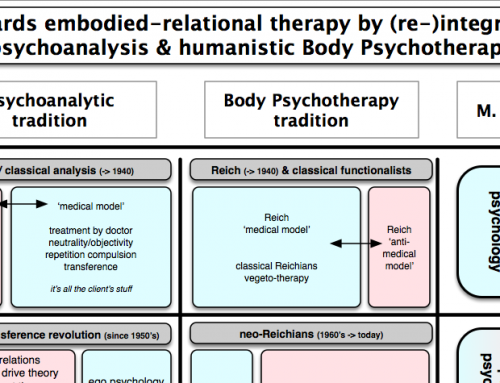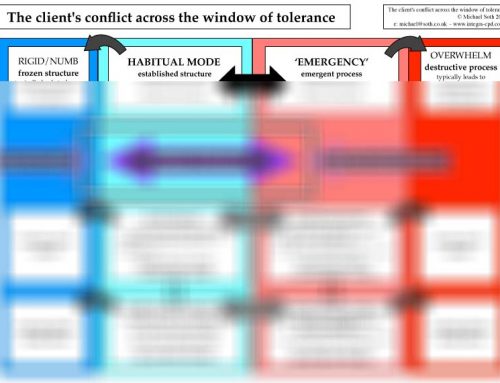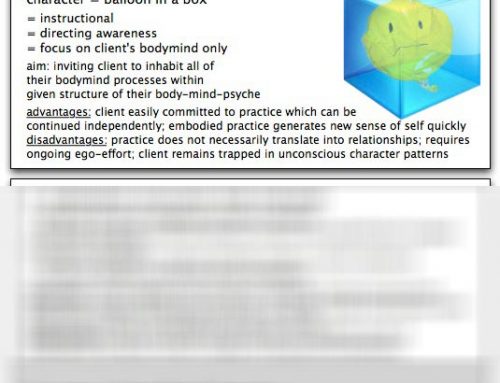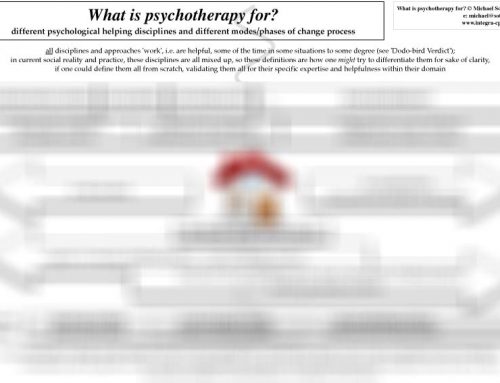Project Description
Perception, understanding and therapeutic response/intervention are shaped by the therapist's implicit relational stance (in the paradigm clash between the polarities of 'medical model' versus 'anti-medical model', and integrated by a third paradoxical position: holistic-systemic-relational). After using earlier and more confused versions of this handout during the early 1990's, this handout finally summarises different modalities of perception, understanding and intervention and re-integrates the 'medical model', after I had been questioning and de-constructing it for some years and battling against it. Pursuing an integrative perspective, I was trying to find a language for describing the therapist's internal process that would speak to and 'work' across all the therapeutic approaches, helping us to attend in detail to the therapist's stream of consciousness and embodied self-awareness. What could we call these internal processes which occur within the therapist, whatever their theory or approach, in such a way that all therapists could relate to it? I never found terms that were entirely satisfying, but I settled on 'perception', 'understanding' and 'intervention' (as long as it was understood that intervention could mean just being, or remaining silent). During the 1990s, a debate was raging throughout the counselling field between two opposing paradigms: the 'medical model'/treatment paradigm on the one hand and the ""it's the relationship that matters"" paradigm on the other. This debate had, of course, been going on throughout the field for decades, but it came to a head again then (and I had been through a similar process within myself - see What therapeutic hope for a subjective mind in an objectified body?). Having battled against hidden 'medical model' assumption in my own tradition, I came to realise that in many ways therapy hinges on keeping that conflict between the paradigms alive as a constant tension within the work, neither being able to subscribe to the 'medical model', nor being able to entirely exclude it. That's why I suggested that embracing the paradigm clash (see also this presentation on the same topic) is a crucial step which the field needs to take, rather than remaining either dogmatically polarised on either side (which was the dominant atmosphere in the 1990s in the professional debate) or confusedly oscillating between these paradigms in practice (which was the day-to-day experience of most therapists, and still is). This handout summarises how an integrative stance between the polarities of 'treatment' and 'relationship' manifests and engenders different ways of perceiving, understanding/ reflecting and responding/intervening therapeutically. After a general definition of these processes (which - although we can distinguish them in principle in the abstract - are almost indistinguishable in our own internal process moment-to-moment where they constantly interweave), I suggest how perception, understanding and intervention are different from a 'medical model' stance, its dogmatic opposite, the 'anti-medical model' stance and from an embracing, integrative position. In trying to clarify the detail of how a relational therapist engages with perceptions, understandings and interventions, it was important to formulate both a 'medical model' stance (where perception - understanding - intervention becomes examination - diagnosis - treatment) as well as an anti-'medical model' stance (which denies any validity to objectifying attitudes in a therapist). The relational position can then be described as a postmodern, integral, systemic third stance which both transcends and includes both 'medical model' and anti-'medical model' stances in a paradoxical embrace. We therefore end up with four different charts: 1. the generic definition of perception - understanding - intervention 2. the dogmatic objectifying 'medical model' version (diagnosis and prescription) 3. the equally dogmatic anti-'medical model' version; and finally 4. the relational version which embraces the conflicts and tensions between the two polarised paradigms
To gain access to the full resource, please log-in if you are a member already (and then re-fresh this page after log-in), or to become a member of the site register here (it's free).







